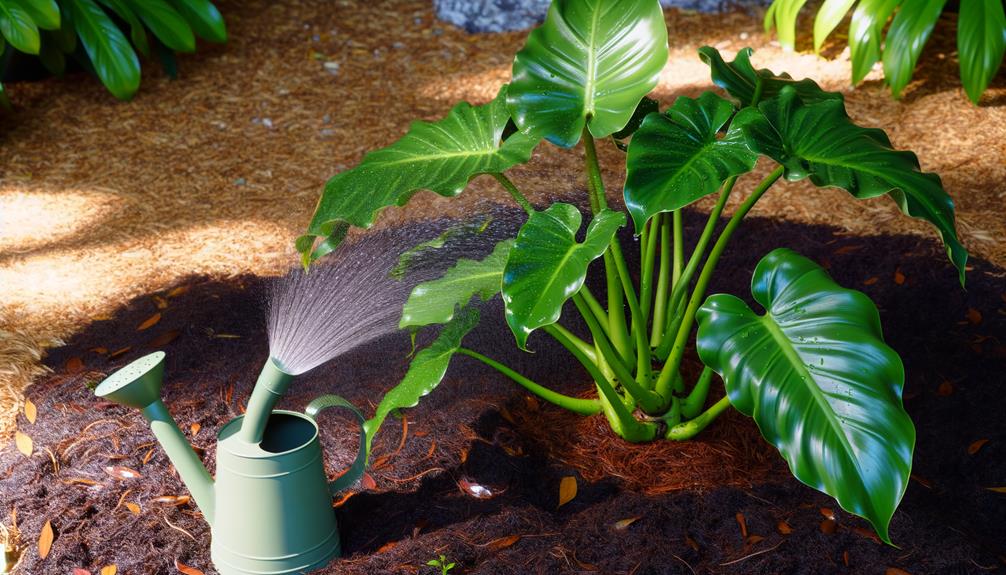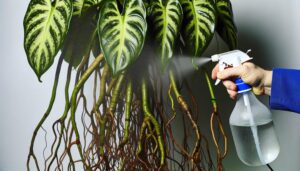How Do I Care for a Philodendron Selloum Outdoors? Tips!
To care for a Philodendron Selloum outdoors, select a site with partial shade and protection from strong winds. Make sure the soil is well-draining, rich in organic material, and maintains a pH between 5.5 and 7.0.
Water consistently, allowing the top inch of soil to dry between watering. Fertilize every 4-6 weeks with a diluted, balanced water-soluble fertilizer.
Maintain humidity between 60% and 80%, and employ misting or pebble trays as needed. During winter, keep temperatures above 55°F, use mulch for insulation, and reduce watering.
Following these guidelines will promote robust growth and peak health. Discover the nuances of maintenance for thriving outdoor Philodendron Selloum.

Key Takeaways
- Place in partial shade with morning sun and afternoon shade to prevent leaf scorching.
- Use well-draining soil rich in organic material, maintaining a pH between 5.5 and 7.0.
- Water thoroughly when the top inch of soil is dry, adjusting frequency based on climate.
- Apply balanced, diluted water-soluble fertilizer every 4-6 weeks to promote growth.
- Maintain humidity levels between 60% and 80%, using misting or pebble trays if necessary.
Choosing the Right Location
Selecting a suitable spot for your Philodendron Selloum is essential to ensuring its finest growth and health. This species thrives in areas with partial shade, where it can receive filtered sunlight. Direct sunlight should be avoided as it can cause leaf scorching.
Aim for an ambient temperature range of 65°F to 80°F, as temperatures below 55°F can hinder growth. Make sure the location is shielded from strong winds to prevent physical damage to the plant’s large, delicate leaves. Additionally, provide ample space for growth, considering that a mature Philodendron Selloum can spread up to 10 feet wide.
Ideal Soil Conditions
To maximize growth, Philodendron Selloum requires well-draining soil with a rich organic material content. The soil should have a pH range between 5.5 and 7.0 to optimize nutrient absorption. Incorporate compost or well-rotted manure to enhance soil fertility. Additionally, the substrate must retain moisture without becoming waterlogged, ensuring aeration for root health.
| Soil Component | Function |
|---|---|
| Organic Material | Provides nutrients, improves composition |
| Sand | Improves drainage |
| Clay | Maintains moisture, provides minerals |
A balanced mixture of these components will create an ideal environment for the Philodendron Selloum. Regularly amend the soil to maintain its nutrient profile and structure, ensuring the plant’s robust development. Proper soil management is essential to support the plant’s overall health and longevity.
Watering Guidelines
Proper irrigation practices are essential for maintaining the health of Philodendron Selloum when cultivated outdoors.
Best watering frequency should be determined by monitoring soil moisture levels, ensuring the substrate remains consistently moist yet well-drained.
To achieve this balance, it is important to implement a systematic approach to assess and adjust watering schedules based on environmental conditions and plant requirements.
Optimal Watering Frequency
Determining the best watering frequency for Philodendron Selloum requires a thorough understanding of its specific moisture needs and the environmental conditions of its outdoor setting.
Observational data suggests that this species thrives in consistently moist, but not waterlogged, soil. To achieve prime hydration, it is recommended to water the plant thoroughly once the top inch of soil becomes dry.
In temperate climates, this generally equates to a bi-weekly watering schedule during active growth periods. However, in hotter, arid regions, more frequent irrigation may be necessary.
Conversely, during cooler months, watering can be reduced to prevent over-saturation. Monitoring local weather patterns and adjusting accordingly is crucial to ensuring the plant’s vitality and growth.
Soil Moisture Levels
Maintaining suitable soil moisture levels is crucial for the best health and growth of Philodendron Selloum. Best moisture can be achieved through consistent irrigation practices, ensuring the soil remains evenly moist but not waterlogged.
Employ a well-draining soil mix to prevent root rot, integrating organic matter such as compost to enhance soil structure and moisture retention. Regularly monitor the top 2-3 inches of soil; it should be slightly dry before rewatering.
During periods of increased heat or drought, increase watering frequency while avoiding excess saturation. Utilize mulch to retain moisture and regulate soil temperature. Implementing these guidelines will foster a robust root system, promoting lush foliage and overall plant well-being.
Light Requirements
Understanding the best light conditions is important for the healthy growth of a Philodendron Selloum when cultivated outdoors. This tropical plant thrives in environments that offer bright, indirect sunlight. Direct exposure to harsh sunlight can cause leaf burn, while insufficient light can stunt growth.
For best results, position your Philodendron Selloum in a location where it can receive filtered light, such as under a canopy or dappled shade.
| Light Condition | Impact on Philodendron Selloum |
|---|---|
| Direct Sunlight | Leaf burn, potential damage |
| Bright, Indirect Light | Optimal growth, vibrant foliage |
| Low Light | Stunted growth, leggy appearance |
Proper light management is important; it helps the plant maintain its lush, verdant appearance, thereby enabling it to serve as an aesthetically pleasing addition to any outdoor space.
Fertilizing Tips
Proper fertilization is vital for the robust growth and overall health of Philodendron Selloum when cultivated outdoors.
To optimize nutrient uptake, follow these guidelines:
- Frequency: Apply a balanced, water-soluble fertilizer every 4-6 weeks during the growing season (spring through early autumn).
- Concentration: Dilute the fertilizer to half the recommended strength to prevent nutrient burn and promote gradual nutrient absorption.
- Application Method: Evenly distribute the diluted fertilizer around the base of the plant, avoiding direct contact with the foliage to prevent potential chemical damage.
These steps guarantee your Philodendron Selloum receives essential macro and micronutrients, fostering vigorous growth and resilience. Regular monitoring of soil conditions and plant response is important to adjust fertilization practices as needed.
Pruning Techniques
Pruning Philodendron Selloum involves strategically removing dead or damaged leaves and stems to promote healthy growth and maintain the plant’s aesthetic appeal. Utilize sterilized pruning shears to make clean cuts at the base of the stems.
Make sure you remove any discolored or wilting foliage to prevent disease spread. Regular pruning also encourages fuller growth and ideal sunlight penetration.
| Pruning Step | Emotional Impact |
|---|---|
| Sterilizing Shears | Guarantees plant health, confidence |
| Removing Dead Leaves | Prevents disease, relief |
| Cutting at Base | Stimulates growth, satisfaction |
| Disposing Debris | Maintains cleanliness, order |
| Observing Results | Witnesses beauty, pride |
Always wear gloves to protect your skin from potential irritants. Prune during the growing season to maximize recovery and growth rates.
Pest Control
Effective pest control for Philodendron Selloum necessitates vigilant monitoring and timely intervention to prevent infestations by common pests such as aphids, mealybugs, and spider mites. Implementing an integrated pest management (IPM) approach is recommended.
This involves:
- Regular Inspection: Conduct weekly examinations of both the upper and lower leaf surfaces to detect early signs of pest presence.
- Biological Control: Introduce natural predators, such as ladybugs or predatory mites, to control pest populations without chemical intervention.
- Chemical Control: If infestations become severe, use horticultural oils or insecticidal soaps, ensuring thorough coverage while following manufacturer guidelines to avoid phytotoxicity.
Temperature Tolerance
Philodendron Selloum exhibits peak growth in temperatures ranging from 65 to 80 degrees Fahrenheit, demonstrating significant sensitivity to both frost and prolonged exposure to temperatures below 50 degrees Fahrenheit. To ensure peak health, it is crucial to monitor local climate conditions.
During colder months, consider using frost cloths or moving the plant to a sheltered area to prevent exposure to cold damage. It is also advisable to avoid sudden temperature fluctuations, which can stress the plant and inhibit growth.
Placement in a location that receives consistent warmth, preferably with morning sun and afternoon shade, will foster robust development. Employing mulch around the base can aid in temperature regulation and moisture retention, thereby enhancing the plant’s resilience.
Managing Humidity
Maintaining ideal moisture levels is essential for the health of Philodendron Selloum when cultivated outdoors.
Implementing humidity-boosting techniques, such as misting or using pebble trays, can effectively enhance the microenvironment around the plant.
Monitoring and adjusting local humidity will help the plant’s physiological processes function efficiently, promoting robust growth.
Optimal Moisture Levels
To secure ideal growth for a Philodendron Selloum when cultivated outdoors, it is essential to maintain ambient moisture levels between 60% and 80%. This tropical plant thrives in damp environments, and insufficient moisture can lead to suboptimal growth and health issues.
To secure adequate moisture, follow these guidelines:
- Monitor Moisture Levels: Utilize a hygrometer to regularly measure the moisture in the growing area.
- Watering Schedule: Implement a consistent watering regime, securing the soil remains moist but not waterlogged. Overwatering can lead to root rot.
- Climate Considerations: Be mindful of seasonal changes and adjust moisture management practices accordingly, especially during dry periods.
Humidity-Boosting Techniques
Improving ambient humidity is essential for the best health of a Philodendron Selloum, particularly in outdoor settings where environmental conditions can fluctuate.
One effective method is to employ misting, using a fine spray to create a microenvironment with elevated moisture levels.
Additionally, installing a drip irrigation system can maintain consistent soil moisture, indirectly enhancing local humidity.
Strategically placing water-filled trays or shallow containers around the plant can also facilitate evaporative humidity.
Besides, mulching with organic materials like bark or compost can reduce water evaporation and help retain soil moisture.
To end, grouping multiple plants together can create a microclimate that naturally increases humidity, benefiting the Philodendron Selloum and neighboring flora alike.
Winter Care
Preparing Philodendron Selloum for winter requires meticulous attention to temperature regulation and protective measures against frost. These tropical plants are highly sensitive to cold temperatures, necessitating specific care protocols to guarantee their survival during winter months.
Temperature Monitoring: Maintain a consistent ambient temperature above 55°F (13°C) by utilizing frost cloths or moving the plant indoors during freezing nights.
Mulching: Apply a 2-3 inch layer of organic mulch around the base to insulate the root system, preserving soil moisture and temperature.
Water Management: Reduce watering frequency to prevent root rot, as the plant’s metabolic rate decreases in colder conditions.
Dwarf Philodendron Selloum
Dwarf Philodendron Selloum, also known as Philodendron bipinnatifidum ‘Little Hope’ or ‘Xanadu,’ is a compact variety of the larger Philodendron Selloum. It has deeply lobed, glossy green leaves and grows in a bushy, upright form, making it suitable for indoor spaces and smaller gardens.
Key Characteristics:
- Size: Reaches about 2-3 feet in height and width.
- Leaves: Deeply lobed and glossy green.
- Light: Thrives in bright, indirect light but can tolerate lower light conditions.
- Water: Keep the soil consistently moist but not waterlogged; allow the top inch of soil to dry out between waterings.
- Temperature: Prefers temperatures between 65-80°F (18-27°C).
Dwarf Philodendron Selloum is a popular choice for adding tropical greenery to homes and offices due to its manageable size and attractive foliage.
Conclusion
The best care of Philodendron selloum in an outdoor setting requires careful attention to its location, soil makeup, watering schedule, and sunlight exposure.
Adding nutrients, preventing pests, regulating temperature, and managing humidity are essential.
With thoughtful winter preparations, this plant can flourish, improving the surrounding greenery.
Implementing these gardening practices will boost the plant’s strong growth and health, adding to the beauty and ecological importance of the environment.






